| Article ID | Journal | Published Year | Pages | File Type |
|---|---|---|---|---|
| 4989892 | Separation and Purification Technology | 2017 | 6 Pages |
⢓Cr-keeper” nanoparticles (CKN) are prepared by in situ reaction for the first time.â¢CKN can copy the cell structure from the kelp template.â¢CKN is an excellent “Cr-against” adsorbent for the separation of trace V (V) from Cr (VI) solution.
“Cr-keeper” nanoparticles (CKN) are in-situ synthesized based on the challenge of separation trace vanadium (V) from chromium (VI) in aqueous solution. Kelp is used as the bio-template and it can react with chromium (VI). Transmission electron microscopy (TEM) results reveal that CKN can copy the cell structure from kelp and the specific surface area of CKN is 343.20 m2/g. Fourier transform infrared (FT-IR) and X-ray photoelectron spectroscopy (XPS) analysis confirm the formation of hydroxyl and Cr (III) species in CKN. The adsorption capacity of V (V) onto CKN is 51.20 mg/g and the maximum separation coefficient (βV/Cr = 3900) is achieved at pH 3.00. The adsorption kinetics follow pseudo-first-order model and Weber-Morris intra particle diffusion model. The adsorption isotherms follow the Sips model. The regeneration and reusability of CKN are discussed. All the results suggest that the utilization of biomass's cell structure as the template for the fabrication of adsorbent with “Cr-keeper” function is excellent, which will bring new directions for Cr (VI) system purification.
